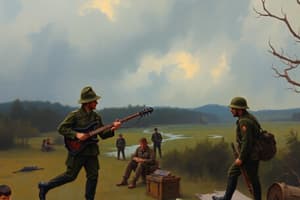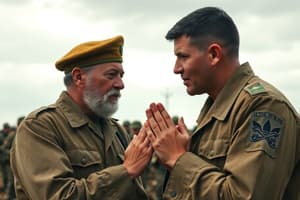Podcast
Questions and Answers
Given the described domestic setting amidst escalating conflict, evaluate the most nuanced interpretation of the children's initial huddled response to the bombing, considering both primal fear and emergent familial socio-emotional dynamics.
Given the described domestic setting amidst escalating conflict, evaluate the most nuanced interpretation of the children's initial huddled response to the bombing, considering both primal fear and emergent familial socio-emotional dynamics.
- A nascent understanding of systemic violence, prompting a conscious seeking of parental reassurance as symbolic figures of stability and protection.
- A complex interplay of innate fear and learned dependence, where the act of huddling signifies both a biological stress response and a culturally mediated behavior for seeking familial solace. (correct)
- A purely instinctual fear response, undifferentiated from adult reactions, reflecting a uniformly shared terror of immediate physical threat.
- An undifferentiated anxiety response, primarily driven by sensory overload from the auditory and vibratory impact of explosions, overshadowing cognitive threat assessment.
Analyze the epistemological implications of the children's development of a system to gauge conflict proximity based on electricity outages, within the context of a technologically disrupted environment and limited access to reliable information.
Analyze the epistemological implications of the children's development of a system to gauge conflict proximity based on electricity outages, within the context of a technologically disrupted environment and limited access to reliable information.
- Demonstrates a sophisticated empirical methodology for assessing environmental threats, indicative of advanced scientific reasoning under duress.
- Illustrates a regression to pre-operational thought, substituting superstitious beliefs about technology for rational understanding of conflict dynamics.
- Represents a pragmatic adaptation utilizing available sensory data to construct a functional, albeit potentially fallible, model of their immediate reality. (correct)
- Signifies a complete epistemological rupture, wherein traditional modes of knowledge acquisition are abandoned in favor of experiential, but ultimately unreliable, heuristics.
Considering the narrator's differentiation between bombings, shelling, and machine gunfire, evaluate the cognitive process employed in categorizing these distinct forms of conflict, focusing on the interplay of auditory perception, contextual awareness, and threat assessment.
Considering the narrator's differentiation between bombings, shelling, and machine gunfire, evaluate the cognitive process employed in categorizing these distinct forms of conflict, focusing on the interplay of auditory perception, contextual awareness, and threat assessment.
- Largely driven by adult-provided classifications, passively internalized by the children without independent verification or experiential grounding.
- A synthesis of auditory discrimination and contextual integration, where sound characteristics are actively interpreted in conjunction with understood sources and potential dangers. (correct)
- Predominantly a manifestation of hypervigilance, where heightened sensory awareness leads to over-differentiation of stimuli, potentially misattributing causality and intent.
- Primarily reliant on acoustic pattern recognition, processed subcortically, leading to an intuitive, pre-cognitive differentiation based purely on sound signatures.
In the context of sustained traumatic exposure, analyze the paradoxical phenomenon of habituation to bombing, specifically regarding Atal's ability to sleep through it, considering the neurobiological and psychological mechanisms of adaptation and desensitization.
In the context of sustained traumatic exposure, analyze the paradoxical phenomenon of habituation to bombing, specifically regarding Atal's ability to sleep through it, considering the neurobiological and psychological mechanisms of adaptation and desensitization.
Evaluate the strategic and tactical implications of the rumor that 'the military operation was ineffective' and 'the Taliban were going to take control of Swat,' considering the psychological impact on civilian morale and potential shifts in power dynamics within the conflict.
Evaluate the strategic and tactical implications of the rumor that 'the military operation was ineffective' and 'the Taliban were going to take control of Swat,' considering the psychological impact on civilian morale and potential shifts in power dynamics within the conflict.
Analyze the narrator's escalating prayer ritual—from individual protection to global supplication—through the lens of psychosocial coping mechanisms under extreme duress, considering the functions of ritualistic behavior, cognitive reappraisal, and expanded empathy.
Analyze the narrator's escalating prayer ritual—from individual protection to global supplication—through the lens of psychosocial coping mechanisms under extreme duress, considering the functions of ritualistic behavior, cognitive reappraisal, and expanded empathy.
Within the narrative context, deconstruct the significance of the phrase 'Candy from the Sky' as a potential metaphor for the aerial bombardment, considering the juxtaposition of childlike innocence and the harsh realities of violent conflict.
Within the narrative context, deconstruct the significance of the phrase 'Candy from the Sky' as a potential metaphor for the aerial bombardment, considering the juxtaposition of childlike innocence and the harsh realities of violent conflict.
Considering the narrative arc, from initial terror to eventual habituation and prayerful coping, evaluate the long-term psychological resilience demonstrated by the narrator in adapting to chronic conflict, focusing on the interplay of fear, adaptation, and hope.
Considering the narrative arc, from initial terror to eventual habituation and prayerful coping, evaluate the long-term psychological resilience demonstrated by the narrator in adapting to chronic conflict, focusing on the interplay of fear, adaptation, and hope.
Analyze the narrative structure of the excerpt, particularly the shift from immediate sensory experience (bombing, shaking) to cognitive interpretation (types of attacks, rumors), in terms of its contribution to conveying the psychological impact of prolonged conflict on developing consciousness.
Analyze the narrative structure of the excerpt, particularly the shift from immediate sensory experience (bombing, shaking) to cognitive interpretation (types of attacks, rumors), in terms of its contribution to conveying the psychological impact of prolonged conflict on developing consciousness.
In light of the concluding sentence, 'One day my prayer was answered. The army hadn't won, but it had at least driven the Taliban into hiding, if not away,' critically evaluate the nature of 'peace' achieved, considering the ambiguity of the Taliban's status and the potential for latent conflict.
In light of the concluding sentence, 'One day my prayer was answered. The army hadn't won, but it had at least driven the Taliban into hiding, if not away,' critically evaluate the nature of 'peace' achieved, considering the ambiguity of the Taliban's status and the potential for latent conflict.
Flashcards
Bombing
Bombing
An attack usually carried out by the Taliban, involving explosives.
Shelling
Shelling
Firing artillery from helicopters or mountaintops, typically by the army.
Machine guns
Machine guns
Rapid-fire weapons used by both the Taliban and the army.
Ayat al-Kursi
Ayat al-Kursi
Signup and view all the flashcards
Military operation
Military operation
Signup and view all the flashcards
Hope amidst chaos
Hope amidst chaos
Signup and view all the flashcards
Fear of night
Fear of night
Signup and view all the flashcards
Crowded sleep
Crowded sleep
Signup and view all the flashcards
Community prayer
Community prayer
Signup and view all the flashcards
Resilience
Resilience
Signup and view all the flashcards
Study Notes
Experiences during Wartime
- Family hid inside during shelling, peering through curtains
- Loud noise, bright light, rattling windows, dishes clattering
- Multiple types of attacks: bombing (Taliban, sometimes remote or suicide), shelling (army), and machinegun fire
- Taliban attempted to take control of Swat, military operation was ineffective
- 10,000 soldiers involved, fighting lasted for 1.5 years
- Sleep on blankets on the floor due to overcrowding
Protecting Oneself during Wartime
- Using verses from the Quran to keep safe (e.g., Ayat al-Kursi)
- Repeating prayers for safety: house, neighborhood, town, Swat, Pakistan, and the world
- Tried to plug ears during bombing blasts
Post-War Observations
- Reportedly felt safe each morning after attacks
- Praying for peace for everyone, especially Swat
Studying That Suits You
Use AI to generate personalized quizzes and flashcards to suit your learning preferences.
Description
Experiences of a family during wartime, including hiding during shelling and various attacks. Protective measures such as reciting Quranic verses and prayers were employed. Observations after the war focused on feeling safe and praying for peace.




